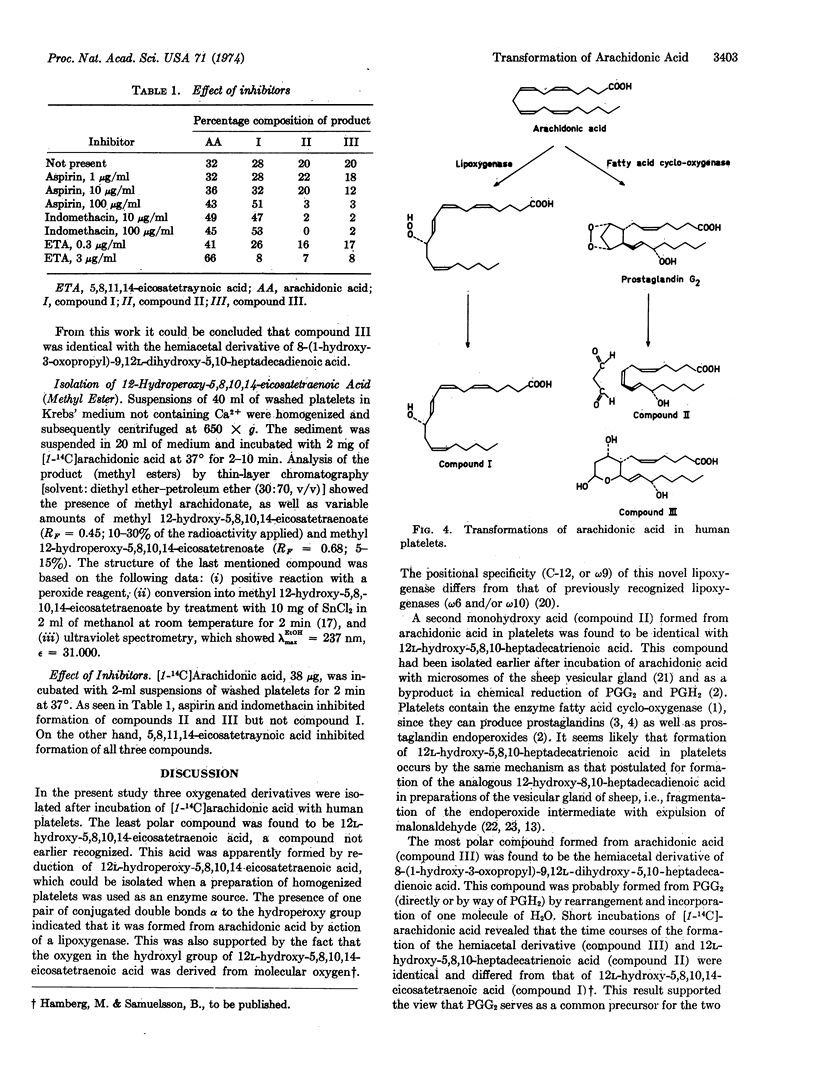Abstract
Arachidonic acid incubated with human platelets was converted into three compounds, 12L-hydroxy-5,8,10,14-eicosatetraenoic acid, 12L-hydroxy-5,8,10-heptadecatrienoic acid, and the hemiacetal derivative of 8-(1-hydroxy-3-oxopropyl)-9,12L-dihydroxy-5,10-heptadecadienoic acid. The formation of the two latter compounds from arachidonic acid proceeded by pathways involving the enzyme, fatty acid cyclo-oxygenase, in the initial step and with the prostaglandin endoperoxide, PGG2, as an intermediate. The first mentioned compound was formed from 12L-hydroperoxy-5,8,10,14-eicosatetraenoic acid, which in turn was formed from arachidonic acid by the action of a novel lipoxygenase. Aspirin and indomethacin inhibited the fatty acid cyclo-oxygenase but not the lipoxygenase, whereas 5,8,11,14-eicosatetraynoic acid inhibited both enzymes. The almost exclusive transformation of the endoperoxide structure into non-prostaglandin derivatives supports the hypothesis that the endoperoxides can participate directly and not by way of the classical prostaglandins in regulation of cell functions. The observed transformations of arachidonic acid in platelets also explain the aggregating effect of this acid.
Keywords: platelet lipoxygenase, fatty acid cyclo-oxygenase, endoperoxide metabolites, platelet aggregation
Full text
PDF




Selected References
These references are in PubMed. This may not be the complete list of references from this article.
- Clausen J., Srivastava K. C. The synthesis of prostaglandins in human platelets. Lipids. 1972 Apr;7(4):246–250. doi: 10.1007/BF02533221. [DOI] [PubMed] [Google Scholar]
- Downing D. T., Ahern D. G., Bachta M. Enzyme inhibition by acetylenic compounds. Biochem Biophys Res Commun. 1970 Jul 13;40(1):218–223. doi: 10.1016/0006-291x(70)91069-7. [DOI] [PubMed] [Google Scholar]
- Downing D. T. Differential inhibition of prostaglandin synthetase and soybean lipoxygenase. Prostaglandins. 1972 Jun;1(6):437–441. doi: 10.1016/0090-6980(72)90012-3. [DOI] [PubMed] [Google Scholar]
- Hamberg M., Israelsson U. Metabolism of prostaglandin E2 in guinea pig liver. I. Identification of seven metabolites. J Biol Chem. 1970 Oct 10;245(19):5107–5114. [PubMed] [Google Scholar]
- Hamberg M., Niehaus W. G., Jr, Samuelsson B. Preparation, isolation, and characterization of a derivative of malonaldehyde. Anal Biochem. 1968 Jan;22(1):145–153. doi: 10.1016/0003-2697(68)90268-6. [DOI] [PubMed] [Google Scholar]
- Hamberg M., Samuelsson B. Detection and isolation of an endoperoxide intermediate in prostaglandin biosynthesis. Proc Natl Acad Sci U S A. 1973 Mar;70(3):899–903. doi: 10.1073/pnas.70.3.899. [DOI] [PMC free article] [PubMed] [Google Scholar]
- Hamberg M., Samuelsson B. On the specificity of the oxygenation of unsaturated fatty acids catalyzed by soybean lipoxidase. J Biol Chem. 1967 Nov 25;242(22):5329–5335. [PubMed] [Google Scholar]
- Hamberg M., Samuelsson B. Oxygenation of unsaturated fatty acids by the vesicular gland of sheep. J Biol Chem. 1967 Nov 25;242(22):5344–5354. [PubMed] [Google Scholar]
- Hamberg M. Steric analysis of hydroperoxides formed by lipoxygenase oxygenation of linoleic acid. Anal Biochem. 1971 Oct;43(2):515–526. doi: 10.1016/0003-2697(71)90282-x. [DOI] [PubMed] [Google Scholar]
- Hamberg M., Svensson J., Wakabayashi T., Samuelsson B. Isolation and structure of two prostaglandin endoperoxides that cause platelet aggregation. Proc Natl Acad Sci U S A. 1974 Feb;71(2):345–349. doi: 10.1073/pnas.71.2.345. [DOI] [PMC free article] [PubMed] [Google Scholar]
- Nugteren D. H., Hazelhof E. Isolation and properties of intermediates in prostaglandin biosynthesis. Biochim Biophys Acta. 1973 Dec 20;326(3):448–461. doi: 10.1016/0005-2760(73)90145-8. [DOI] [PubMed] [Google Scholar]
- Samuelsson B. Biosynthesis of prostaglandins. Fed Proc. 1972 Sep-Oct;31(5):1442–1450. [PubMed] [Google Scholar]
- Schoene N. W., Iacono J. M. Use of lysed human platelets to study prostaglandin E2 production. Prostaglandins. 1974 Feb 25;5(4):387–395. doi: 10.1016/s0090-6980(74)80122-x. [DOI] [PubMed] [Google Scholar]
- Silver M. J., Hoch W., Kocsis J. J., Ingerman C. M., Smith J. B. Arachidonic acid causes sudden death in rabbits. Science. 1974 Mar 15;183(4129):1085–1087. doi: 10.1126/science.183.4129.1085. [DOI] [PubMed] [Google Scholar]
- Smith J. B., Ingerman C., Kocsis J. J., Silver M. J. Formation of prostaglandins during the aggregation of human blood platelets. J Clin Invest. 1973 Apr;52(4):965–969. doi: 10.1172/JCI107262. [DOI] [PMC free article] [PubMed] [Google Scholar]
- Smith J. B., Willis A. L. Formation and release of prostaglandins by platelets in response to thrombin. Br J Pharmacol. 1970 Nov;40(3):545P–546P. [PMC free article] [PubMed] [Google Scholar]
- Vane J. R. Inhibition of prostaglandin synthesis as a mechanism of action for aspirin-like drugs. Nat New Biol. 1971 Jun 23;231(25):232–235. doi: 10.1038/newbio231232a0. [DOI] [PubMed] [Google Scholar]
- Vargaftig B. B., Zirinis P. Platelet aggregation induced by arachidonic acid is accompanied by release of potential inflammatory mediators distinct from PGE2 and PGF2. Nat New Biol. 1973 Jul 25;244(134):114–116. doi: 10.1038/newbio244114a0. [DOI] [PubMed] [Google Scholar]
- Willis A. L. An enzymatic mechanism for the antithrombotic and antihemostatic actions of aspirin. Science. 1974 Jan 25;183(4122):325–327. doi: 10.1126/science.183.4122.325. [DOI] [PubMed] [Google Scholar]
- Wlodawer P., Samuelsson B. On the organization and mechanism of prostaglandin synthetase. J Biol Chem. 1973 Aug 25;248(16):5673–5678. [PubMed] [Google Scholar]


